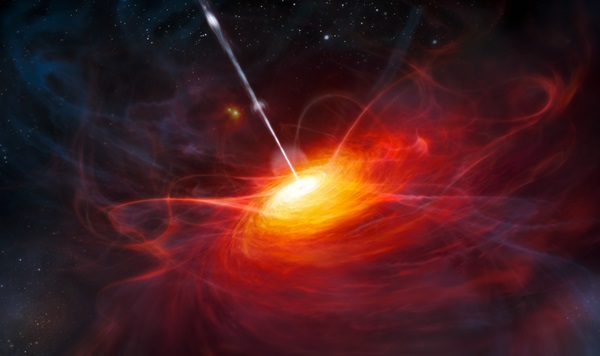Key Takeaways:
Quasars are extremely bright, extremely distant objects. They are the disks of material around supermassive black holes, which heat up and glow as material streams inward toward the event horizon. And now, the Sloan Digital Sky Survey (SDSS) has identified more than 147,000 of these objects in the distant universe to create a first-of-its-kind 3-dimensional map of the early universe that is also the largest such map available to date.
The observations were taken over the course of two years as part of the SDSS Extended Baryon Oscillation Spectroscopic Survey, abbreviated eBOSS, which uses the Sloan Foundation 2.5m Telescope at Apache Point Observatory. eBOSS aims to more accurately measure the expansion history of the universe. The quasars in the study were spotted shining at a time when the universe was between 3 and 7 billion years old.
This new, more complete map of the universe and its expansion history agrees with the standard cosmology astronomers have developed over the past two decades and are currently using today, which includes properties such as Einstein’s general theory of relativity and the existence of dark matter and dark energy.
Studying this time frame is particularly important because it’s the epoch leading up to when the universe’s expansion changed from a decelerating to an accelerating expansion. That happened when the universe was roughly 7.8 billion years old, or about 6 billion years ago. Today, that acceleration continues — in short, objects farther away from us are receding faster, and continue to do so because of a cosmological component called dark energy. Characterizing the exact nature of this transition from a decelerating to accelerating universe can place further constraints on the nature of dark energy, which is the dominant component in our universe at the present time.
In a recent press release, Will Percival, a professor of cosmology at the University of Portsmouth and the eBOSS survey scientist, explains, “Even though we understand how gravity works, we still do not understand everything – there is still the question of what exactly dark energy is. We would like to understand dark energy further.”
eBOSS is looking into the nature of dark energy by studying “baryonic acoustic oscillations,” or BAOs. BAOs are the remnant signature of sound waves traveling through the very early universe; when the universe was about 380,000 years old, these sound waves were essentially frozen in place by changing conditions. Since then, their signature has been stretched by the expansion of the universe. But astronomers have a good idea of what the BAOs should have looked like at the time they were frozen, making the changes we see in BAOs over time a clear record of the universe’s expansion over time.
Thus, BAOs can be used as a sort of “standard ruler” by cosmologists. The size of the oscillations corresponds to the most likely distance between galaxies, including the quasars that reside within them. According to Pauline Zarrouk, a PhD student at the University Paris-Saclay, “You have metres for small units of length, kilometers or miles for distances between cities, and we have the BAO for distances between galaxies and quasars in cosmology.”
Today, the distribution of galaxies (and their quasars) is a reflection of the frozen-in BAOs, so the better we can map the universe, the better we can understand how its expansion has changed over time, independent of other ways of measuring that expansion, such as using supernovae or lensed quasars.
Thus far, “Our results are consistent with Einstein’s theory of general relativity” says Hector Gil-Marin of the Laboratoire de Physique Nucléaire et de hautes Énergies in Paris. Gil-Marin is one of the astronomers who contributed to the analysis of the quasars and the creation of the map. “We now have BAO measurements covering a range of cosmological distances, and they all point to the same thing: the simple model matches the observations very well.”
Even as eBOSS continues through 2020, there are plans for future sky surveys to increase the detail of such maps by a factor of ten, helping to paint an ever-clearer picture of our universe’s past.










